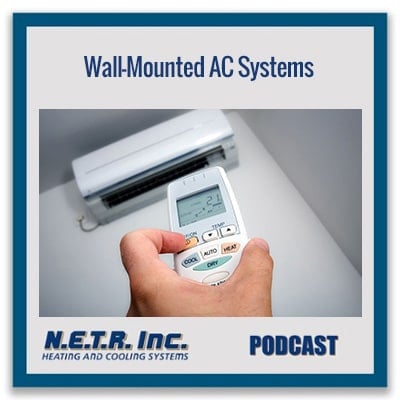
In this podcast, Brett Rogenski, General Manager of NETR, Inc, talks about wall-mounted AC systems. He explains how they work, why they’re so efficient, and how they can help with heating and cooling your home.
John Maher: Hi, I’m John Maher. I’m here today with Brett Rogenski, general manager of N.E.T.R., Inc., a heating and cooling company in Massachusetts with a focus on Mitsubishi ductless heating and cooling products. Today, we’re talking about wall mounted AC systems.
Welcome, Brett.
Brett Rogenski: Hey. Thanks a lot for having me, John.
Wall-Mounted AC Vs. Other Types of ACs
John: Sure. So, Brett, what is a wall mounted AC unit otherwise known as a mini-split, a ductless system, a heat pump? How does that differ from other types of AC systems?
Brett: Sure. That’s a great question. So, what a lot of people think of as a traditional system is a traditional central air system. You have duct work going through your home that then moves the air to a coil, which has refrigerant in it, and that refrigerant then removes that heat from the air and pushes it. The ducts push it back out to your house.
In a ductless system, a mini-split heat pump, whatever you’re saying, we actually don’t move the air. There’s a fan in there that circulates air, but we actually move the heat. So, the fan in the unit is on. The air in the room, it goes over a coil like that again. But we’re actually then taking that and moving it out to the outdoor unit to dispense that heat to the outside. So, instead of moving all the air to the cooling, we actually move the cooling to the air. So, it’s a much more efficient system in those regards.
Benefits of Wall-Mounted ACs
John: Okay. And what are some of the benefits of choosing a wall mounted AC unit for the home, and are there any drawbacks or limitations to that type of system?
Brett: There’s not many drawbacks or limitations to the system. So, the biggest advantage is, two advantages that I think of frequently are, first is efficiency. So, typically ductless, mini-splits, heat pumps, however you want to call them, are more efficient than even some of the best central air units that you can get, so they’re very highly efficient.
The second is, a lot of folks don’t have the infrastructure, especially here in New England where we have a lot of older homes and stuff, they don’t have the infrastructure to use a ducted in solution. So, for instance, if I had a colonial in North Andover that I heat with baseboard hot water, pretty typical type thing here, there is no duct work for me to work with for central air. So, I either have to invest and spend the money in building all that, and then, I go put in an AC system which probably won’t be as efficient as the ductless system, or with ductless, we can simply mount some of the infrastructure to the outside of the house. We make well sealed penetrations into the home, and then, we wall mount heads to help you cool those rooms.
The other thing that’s nice is every single device, every single one of those wall mounted air conditioners, those wall mounted heads, works independently. So, with a central air system, for instance, a lot of folks have two zones, the upstairs and the downstairs. In a colonial, you set the temperature for the downstairs, it’s that same temperature in every room downstairs, set the temperature for upstairs. It’s the same temperature in all the rooms. There’s no variability.
With a ductless system, each one of those heads can run independently. So, if you wanted your bedroom to be 68, but your guest room, you wanted to shut off the cooling and in your child’s room you wanted it to be 72, those are all independent variables. Same thing downstairs, you may want the living room a little cooler than the kitchen. Those can all be set independently. So, that’s some of the great advantages it brings.
Installing a Wall-Mounted AC
John: Okay. And talk a little bit more about how the installation process for a wall mounted AC unit differs from a more traditional AC system.
Brett: So, where the commonality stops is outside. So, we put down a pad just like you see with a central air system, and then, we have a condenser unit that is mounted outside. And that is the thing that moves the refrigerant to and from the heads, and actually, dispenses the heat to the outside. On the outside of the house, we actually run power and refrigerant lines that go to each individual head. Those are then encased in something that we call line hide.
So, it’s that white product that goes on the typically white we can get it in colors that goes on the outside of the house that encases and protects those lines. So, it allows us to do retrofits on existing houses really efficiently. And we work, obviously, the key to making that look good on your home is the design. So, rather than just running it willy-nilly on the outside of your house, running it up close to your trim, that sort of stuff, to be able to have that line height blend away on your home.
Features of Wall-Mounted AC Units
John: And can you talk a little bit about some of the key features and technologies that are available with wall mounted AC units?
Brett: There’s a lot of great things. I already mentioned that each one of those can be managed independently. So, again, your comfort can vary from room to room, depending on who’s there and what you like. Also, the efficiency that you can shut down units when you’re not in use as opposed to conditioning spaces that you’re not using. There’s also things, so for instance, Mitsubishi has their I-see technology, which actually uses a passive infrared sensor that is actually looking in the room and determining what the temperature is in different spaces in the room, and then, actually directing air towards those spaces to make the temperature even in the room because in that wall mounted head, there are, let’s call them louvers, okay?
Little veins that are in there that can work and direct air to different spots in the room. So, instead of having a room where, oh, geez, over here by the windows, it’s warmer, it’s actually 78, and over here in the corner by the kitchen it’s 72, that system can actually redirect air to offset that and give you much more even comfort in that room. So, that’s a great technology that’s in there as well.
Can Wall-Mounted ACs Provide Heating?
John: And we’re talking about air conditioning here, but these systems can also provide heat in the wintertime as well. And there are some models that can provide heat even when it’s negative degrees outside? Is that right?
Brett: Yeah, absolutely. So, the neat thing about ductless units is that they can heat, and they can cool by design. So, they do both. There’s something called the reversing valve that goes in there, and essentially, to turn it into a heater, you’re reversing the refrigerant flow situation. So, instead of taking heat outside, now, you’re gathering heat from outside which it’s hard to imagine there’s heat outside when it’s two degrees outside, but there is. It’s gathering that heat from outside and pushing it in, and then, diffusing that through the indoor heads.
The cold climate heat pumps, so for instance, Mitsubishi’s, their hyper heat product can produce heat down to negative 13 Fahrenheit, and that’s an ambient temperature. So, the wind may be howling in its negative 25 with the wind chill, but if the ambient temperature is negative 13 or higher, it’s still able to produce heat and heat your home. So, they’re a great match for the whole New England market.
How NETR Helps People Learn More About Wall-Mounted ACs
John: And how does N.E.T.R help to educate customers on the benefits of this type of wall mounted AC system?
Brett: It all starts with the consultation, and we have a lot of resources. We have a YouTube channel. We have a very informative website with many case studies and a lot of facts about the things. But really the crux of it comes from a consultation on site. Our comfort consultants are all highly trained and factory certified on system design, and they’re going to come in your home because every home is a little different, has different needs, and you have different goals.
So, they’re going to come in, they’re going to perform a heat load calculation on your home that figures out how many BTUs of heating and cooling you need in your home and in each individual space. And they’re going to design a system and offer and present you options to meet your goals. So, everyone’s a little different. Some folks are looking at a ductless system for cooling only. That’s going to be one type of product and one type of design.
Other folks want heating and cooling all year round. That’s going to be, again, a slightly different design and a slightly different product. And some folks are looking to just have supplemental heat maybe during those, what we call the shoulder months, spring, and fall, where I want to run my furnace all the time, but I would like it to be a little warmer in the living.
So, again, that’s a different type of product and limitations of design. So, what we really encourage everyone to do is give us a call, have one of our comfort consultants come out and visit you, and it’s free. And we’re going to help you design something that’s designed with your comfort and your budget in mind.
John: All right. Well, that’s really great information, Brett. Thanks again for speaking with me today.
Brett: Thanks so much for having me.
John: And for more information, you can visit the N.E.T.R. website at ntrinc.com or call 781-933-NETR. That’s 781-933-6387.
